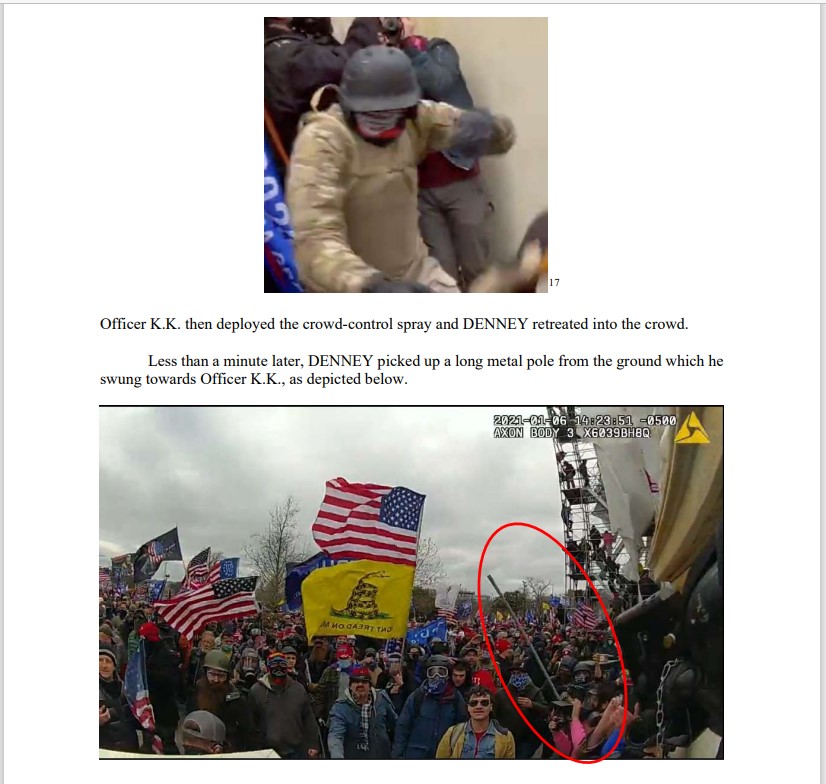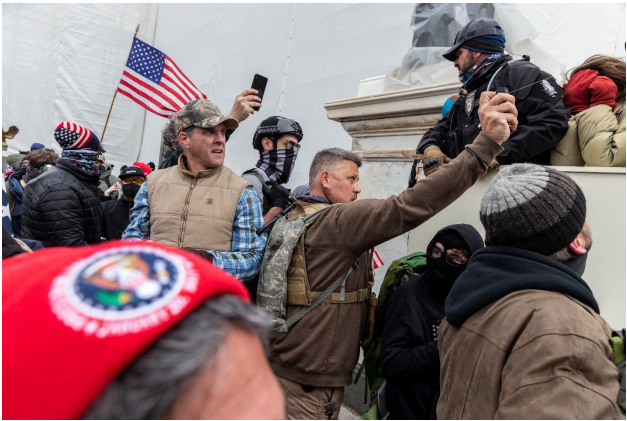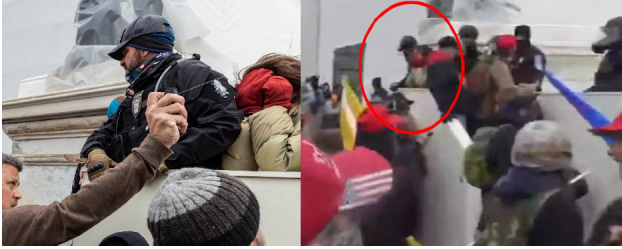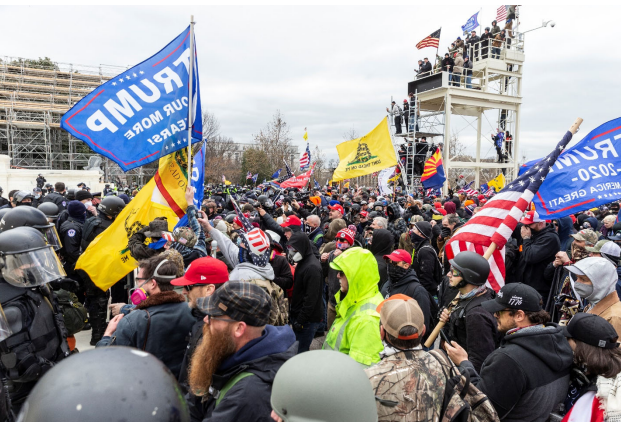Attorneys Claim Government Manufacturing Evidence to Charge, Incarcerate Jan. 6 Prisoners
Rep. Louie Gohmert says ‘if you have evidence that’s of an exonerating nature for the defendant, you have to turn that over.’
As Jan. 6 prisoners continue to languish in jail without trials, without bond and in subhuman conditions, two Jan. 6 attorneys are claiming the government is manufacturing evidence to arrest and incarcerate them. Rep. Louie Gohmert (R-Texas) says the government is also “hiding evidence” that could possibly exonerate some of them.
This is not the first time Democrats have manufactured evidence to support their allegations in a legal proceeding.
A History of Fabricating Evidence
In July of 2018, the infamous Steele dossier was revealed to be little more than a collection of unverified opposition research funded by Hillary Clinton’s presidential campaign and the Democratic National Committee (DNC), to obtain a warrant to spy on former Trump campaign volunteer Carter Page and to derail the Trump campaign.
During a Sept. 26, 2019, Intelligence Committee hearing, Rep. Adam Schiff (D-Calif.) read a fabricated transcript of a phone call between former President Donald Trump and Ukrainian President Volodymyr Zelenskyy. When he was caught, he claimed it was “a parody.”
During the first impeachment trials in February 2021, Rep. Eric Swalwell (D-Calif.) used a photoshopped version of a Twitter post Trump re-tweeted about supporters “fighting” for the country to make it seem more ominous.
After being caught and being forced to admit they doctored a text message between Rep. Jim Jordan (R-Ohio) and former White House chief of staff Mark Meadows during the December 2021 Jan. 6 hearings, and also excluded content about how they had wanted former Vice President Mike Pence to handle electoral votes during the Joint Session of Congress, Jordan further opined that their statement saying “We regret the error,” is really government-speak for, “We got caught lying.”
At the televised House committee hearing related to the protests that took place at the U.S. Capitol in Washington, D.C., on Jan. 6, 2021—Jordan said members of the House select committee had altered a text message exchange between him and former White House chief of staff Mark Meadows “and lied to the American people about it.”
J-6 Cases: ‘Manipulating Evidence’
Joseph McBride, an attorney for multiple Jan. 6 prisoners and defendants, is certain the government is “manipulating evidence.”
“In terms of attorneys,” McBride told The Epoch Times, “I’m probably the most outspoken attorney in the United States of America who is representing Jan. 6 defendants.”
McBride said he has “five, going on six” criminal defendants related to Jan. 6 and three civil rights cases. He also represented five Jan. 6 defendants before the Jan. 6 committee. Considering the depth of his involvement, McBride believes he’s “far and away” the most eligible and outspoken attorney among those attached to the Jan. 6 legal battles.
“You are not allowed to punish a pre-trial detainee in the United States of America because you are innocent until proven guilty” McBride stated. “It is only after you have been convicted of a crime or plead through a crime that you can be punished for a crime. Punishment for a crime is deprivation of freedom. … My clients and others like them have been brutally assaulted. They’ve been locked away in cells for months at a time. They’ve been denied medical care and have had their human rights, their civil rights, and their constitutional rights violated by the staff at the D.C. gulag, by the staff at the Northern Neck jail because they have been green-lighted by the Biden machine to harm anybody who showed up at the Capitol on January 6 to speak out about the election results. It is unconstitutional. It is immoral. It is un-American. It is wrong.”
Suspicious Affidavits
McBride also says the government’s use of lengthy and extravagantly detailed affidavits is “much different than your normal cases and they’re frontloading these complaints with facts that aren’t proven and these allegations are subsequently being weaponized in the court of public opinion.”
According to McBride, complaint affidavits are generally written as hastily as possible because the only purpose of a complaint affidavit is to initiate the legal process by establishing probable cause. Complaint affidavits are normally followed quickly by the return of an indictment by a grand jury.
But the Jan. 6 complaint affidavits can run in excess of 20, 30, 40, and even 50 pages long, which begs the question of “why?”
For McBride, the answer is simple. Because Department of Justice (DOJ) policy only allows the government to make public comments about matters that are already a matter of public record, making sure all of that detail is part of the public record enables the government to release this information to the public to destroy the reputations of the accused ahead of a trial.
Another Jan. 6 attorney, Bill Shipley, is equally convinced the government is manufacturing evidence to support a narrative.
Shipley has called into question the validity of photo and video screenshot “evidence” used in three of his cases. Two of them are outlined below.
According to the 14-page Criminal Complaint (pdf), Brian Christopher Mock has been charged with: “Assaulting, Resisting, or Impeding Certain Officers, Knowingly Entering or Remaining in any Restricted Building or Grounds Without Lawful Authority; Disorderly and Disruptive Conduct in a Restricted Building or Grounds, Obstruction of Law Enforcement During Civil Disorder, Acts of Physical Violence in any of the Capitol Buildings or Grounds.”
However, all of the charges are based on screen grabs from videos that do not confirm the allegations.
Shipley told The Epoch Times “both the government and the court have acknowledged that video 1 does not show any actual assault by defendant Mock as alleged in the indictment.”
“If video 1 showed Mr. Mock kicking the fallen officer it would have been simple to write, ‘The video shows Mr. Mock kicking the fallen officer,’” Shipley said. “Judge Howell didn’t write that because video 1 doesn’t show that. The government knows it, Mr. Mock knows it, and Judge Howell knew it.
“The simple reality is that video 1 shows the unidentified victim officer already on the ground when Mr. Mock is first seen on camera. There are two other protesters—one wearing camouflage and the other wearing a red hat—on the ground with the victim officer at the moment defendant Mock is first seen. Defendant Mock is standing in close proximity to the three of them. He is not seen shoving the fallen officer to the ground.”
According to Shipley, the entire segment of video 1, which is relevant to the first alleged assault, lasts only four seconds. At no point during those four seconds does video 1 show Mock’s foot making contact with any part of the Officer’s body.
“Nevertheless, the government made a proffer in its emergency motion (pdf) that the video showed defendant Mock shoving the officer to the ground and then kicking the officer” and “relied heavily on a single screenshot from the video that appears to show defendant Mock’s right foot off the ground.”
“If the government had video of Mr. Mock’s right foot striking the victim officer, it is quite certain it would have included a screenshot of that particular moment instead of the one it choose,” Shipley argued. “The obvious conclusion is the government has no such video. It hasn’t produced one in discovery.”
Screengrab from video used by the FBI to prove their allegation that Bryan Mock “kicked” a police officer, who was laying on the ground. (FBI criminal complaint for Bryan Mock)
In another incident, Mock is accused of shoving an officer to the ground, causing and injury to the officer’s right elbow.
According to the 14-page criminal complaint (pdf), filed June 10, 2021, by Special Agent Beth Alvarez, “Officer [SK] recalled being shoved onto his back by one of the rioters. During the melee, Officer [SK’s] right elbow was hit right in the area where two protective pads on his arm meet.”
When Mock was arrested, Alvarez—the affiant on the complaint affidavit—wrote the following statement under oath:
“According to Victim 2, his right elbow hit the ground right in the area where two pads come together after the shove, causing excruciating pain at the time of impact.”
The complaint affidavit is dated June 10, 2021, precisely one month after the interview of the officer. During the 30 days between those two documents, the mechanics of how the officer injured his elbow changed. She first wrote he suffered the injury to his elbow “during the melee,” without reference to Mock or his actions. However, one month later, Alvarez wrote that his right elbow hit the ground right in the area where the two pads come together as a result of Mock’s shove.
Brian Mock has created a GiveSendGo account to help offset his ongoing legal expenses.
According to a 42-page criminal complaint (pdf), Denny is charged with: “Assaulting, Resisting, or Impeding Certain Officers with a Deadly or Dangerous Weapon, Civil Disorder, Obstruction of an Official Proceeding, Conspiracy to Obstruct an Official Proceeding, Entering and Remaining in a Restricted Building or Grounds with a Deadly or Dangerous Weapon, Disorderly and Disruptive Conduct in a Restricted Building or Grounds with a Deadly or Dangerous Weapon, Engaging in Physical Violence in a Restricted Building or Grounds with a Deadly or Dangerous Weapon, and an Act of Physical Violence in the Capitol Building.”
On page 27, Special Agent James P. Farris swore under oath:
“Officer K.K. then deployed a crowd-control spray and Denney retreated into the crowd.
Less than a minute later, Denney picked up a long metal pole from the ground which he swung towards Officer K.K., as depicted below.”

Page 27 from the criminal complaint filed by James. P. Farris of the FBI on Dec., 7, 2021 in the United States District Court of the District of Columbia. (FBI criminal complaint)
Shipley said when the government presented this case to the grand jury on the morning of March 7, 2022, the single-count grand jury indictment that was returned charged Denney with “using a dangerous or deadly weapon, that is, a long gray-in-color pole, did forcibly assault” Officer K.K. of the Metropolitan Police Department.
However, the body-worn camera footage from Officer K.K.’s camera showed that the pole was flexed in a manner inconsistent with metal.

Screengrab from video used in Criminal Complaint by the FBI to show Luke Denny was using a metal pole, classified as a dangerous or deadly weapon, to strike police officers. However, the “metal pole” is clearly flexing. The government later admitted it was a plastic sprinkler pipe. Lucas Denny is currently incarcerated for his participation in the Capitol protest in Washington on Jan. 6, 2021. (FBI criminal complaint)
“This is not a circumstance where Special Agent Farris was acting under time pressure,” Shipley contends. “His affidavit in support of the complaint was signed on December 7, 2021, 11 months after the incident. The fact that Farris would be so careless—at best—as to describe the object as a ‘metal pole’ when the video clearly shows it was not—a fact conceded by the government when it was unwilling to go on the record with the grand jury that the pole in question as made of metal—is more than sufficient reason to adopt a cautious approach to any of the other conclusions drawn by Farris in his affidavit.”
According to My Law Questions: “A false affidavit is one in which a person signs it and swears that the statements attested to in the document are true, complete, and accurate when the statements are in fact misleading or false. Submitting a false affidavit is a criminal offense and constitutes perjury in most jurisdictions.”
According to a 17-page criminal complaint (pdf), Christopher Worrell is charged with: “Entering and Remaining in a Restricted Building or Grounds with a Deadly or Dangerous Weapon, Disorderly and Disruptive Conduct in a Restricted Building or Grounds with a Deadly or Dangerous Weapon, Engaging in Physical Violence in a Restricted Building or Grounds Using a Deadly or Dangerous Weapon, Act of Physical Violence in the Capitol Grounds or Buildings, Civil Disorder, Assaulting, Resisting, or Impeding Certain Officers Using a Dangerous Weapon.”
Despite the repeated allegations of using/possessing a “deadly or dangerous weapon,” specifically spraying “pepper gel” at Capitol Hill police, there is no evidence of Worrell actually spraying pepper gel at police officers.
The FBI Task Manager who filed the report admits from the beginning, he did “not currently know with certainty the target at which WORRELL was spraying.”
In the criminal complaint is a photo, supplied by an unnamed photographer, that shows two Capitol Police officers (circled in green) standing atop a staircase near a dark statue wrapped in plastic. Both are leaning forward, spraying the people below—who are standing peacefully and posing no threat to them—in the face with pepper gel. Multiple people in the crowd can be seen covering their faces and reacting in pain. Worrell (circled in red) can be seen standing a sizeable distance away, recording the incident like several others with his cell phone.
Then, using a screenshot from a video that “appears to show” Worrell “at the time” of the pepper gel assault, we are shown there is a man dressed in black standing where the police had been standing, as well as a woman with red gloves covering her face. Worrell can be seen spraying pepper gel beyond these two people. However, it is unclear what or who he is aiming at.

Photo of Chris Worrell spraying a canister of pepper gel while at the capitol building on Jan. 6, 2021. (FBI criminal complaint)
In another screen grab from the video, this one considerably blurred, you can see several other people gathered at the top of the same steps near the dark statue wrapped in plastic, including another man dressed in black with a mask covering his face. But there are no police officers and Worrell does not appear to be there. Yet another pair of screen grabs from the video do show Worrell. However, he is clearly standing at a distance away from the stairs.
As reported by The Epoch Times on June 20, several reports and first-hand eyewitness accounts describe how there was a “covert cadre” of “provocateurs”—widely suspected to be federal agents and Capitol Police officers—who were disguised to mingle among the otherwise peaceful protested for the purpose of instigating acts of violence during the protests for the purposes of entrapment. The Epoch Times further revealed evidence that now proves that “plainclothes” members of a special Electronic Surveillance Unit (ESU) were also embedded among the protesters to “document the actions of the demonstrators and MPD’s response to any civil disobedience or criminal activity.”

Screengrab from video used by the FBI to prove the allegation that Chris Worrell sprayed police with pepper gel. However, the image does not show police being struck with pepper gel. (FBI criminal complaint)

Screengrab from video used by the FBI to prove the allegation that Chris Worrell sprayed police with pepper gel. However, the image does not show police being struck with pepper gel. (FBI criminal complaint)
There are multiple photos showing a line of police officers standing in a completely different location that do not show where Worrell was standing in relationship to them.

Photo showing a line of police officers, used by the FBI to show they were in the area where Chris Worrell was spraying pepper gel. However, Worrell is not seen in the image. (FBI criminal complaint)
However, despite the multiple photographs and screenshots from all the videos used to allege that Worrell “appeared” to be spraying police with pepper gel, there are no photos showing the police were actually standing there when Worrell was spraying the pepper gel or any photos showing the police being hit with or reacting to being hit with pepper gel.
Moreover, after admitting he did not “currently know with certainty the target at which WORRELL was spraying,” and having no evidence showing the target of the pepper gel, why did the investigating agent still said he believes “the likely intended target of WORRELL’s pepper pray assault was the line of law enforcement officers present in these photographs.”
As The Epoch Times reported June 13, Worrell, who was released by order of a federal judge after being denied cancer treatment for eight months, is now “in dire straights,” according to his girlfriend. The cost for his treatments is estimated at about $30,000. Then there is the additional chemotherapy to treat the returning symptoms. For that, he will need at least another $50,000. There is a GiveSendGo account to raise money for Worrell’s treatment.
Evidence Withheld
Machinations such as this remind Gohmert of the Ted Stevens case from back in 2008.
According to a 28-page indictment (pdf), former Sen. Ted Stevens (R-Alaska) was charged with seven counts of making false statements on his Senate financial disclosure forms from 2001 to 2006 and with concealing more than $250,000 worth of gifts, including home renovations, that he received from an Alaska oil services company.
Stevens was prosecuted and convicted and subsequently lost his reelection campaign. Shortly before his tragic death in a plane crash in August 2010, Stevens was exonerated after a whistleblower revealed that prosecutors withheld critical evidence of the Senator’s innocence in violation of his constitutional rights.
“In the Ted Stevens case, we found out the FBI created evidence and hid evidence in order to get a conviction,” Gohmert told The Epoch Times. “He ended up being exonerated but only after he lost his election. We also know that Project Veritas caught a Democratic leader saying we paid for people to come in and instigate violence at Trump events so we could claim Trump was violent. All of these things in the background and you come forward to January 6.”
“We still can’t get all of the videotape,” Gohmert said, referencing the 14,000 hours of surveillance video from Capitol security cameras that has been withheld under “sovereign immunity.” The evidence could be used in the defense of those charged in relation to the incident and being held in jail.
“They continue to hide that information,” Gohmert asserted. “As every lawyer knows who has dealt with any criminal case, it’s been a Constitutional requirement for the Supreme Court for decades, if you have evidence that’s of an exonerating nature for the defendant, you have to turn that over.”
Zachary Stieber and Ken Silva contributed to this report.
" Conservative News Daily does not always share or support the views and opinions expressed here; they are just those of the writer."


Now loading...